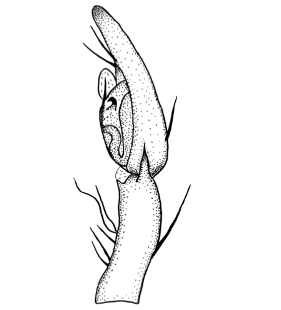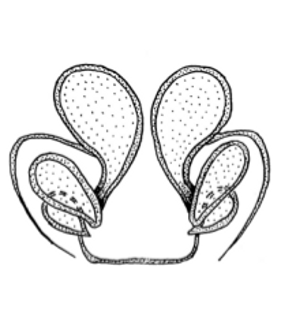Drassodes dagestanus Ponomarev & Alieva, 2008
Description
Male
Palpus femur with on dorso-median spine and an apical group of three spines. Palpus tibia with a long, pointed apophysis. Embolus thin, slightly curved towards the end.
Carapace brown, cephalic region darkened, four pairs of dark radial stripes extending from the median furrow to the carapace margin. Labium, gnathocoxae and chelicerae dark brown. Frontal cheliceral margin with three teeth, of which the median tooth is the largest. Posterior cheliceral margin with one very small tooth. Sternum yellow-brown with a black margin. Legs and palps brown, ventral side of trochanter yellow brown. Tarsus and metataruss I and II with well-developed scopulae.
Dorsum dark gray with a weakly developed lanceolate mark in its anterior part.
Carapace length 3.9 mm, width 2.9 mm.
Body length male: 9.3 mmFemale
Epigynal septum short, its posterior part broader. Spermathecae arranged in a compact group.
Body coloration and cheliceral teeth as in the male. Scopula developed on tarsi and metatarsi I and II.
Carapace length 3.9-5 mm, width 2.7-3.5 mm.
Body length female: 10.4-13.1 mmAdditional information
In the alpine and subnival zones of the NE Caucasus.
Similar to D. lapidosus but not as large and massive, also differing in cheliceral teeth, shape of the male tibial apophysis, shorter epigynal septum and compact spermathecae.
Distribution
Phenology
| Jan | Feb | Mar | Apr | May | Jun | Jul | Aug | Sep | Oct | Nov | Dec |
 |  |
Figures
Distribution List
"No references" does not mean that the species does not occur in this country, but that we have not yet inserted the reference for it. We are working on it.
References
Otto S (2022) Caucasian spiders. A faunistic database on the spiders of the Caucasus Ecoregion. Database version 02.2022. Internet: caucasus-spiders.info.
Ponomarev A V, Alieva S V (2008) New species of spiders of the genus Drassodes Westring, 1851 (Aranei: Gnaphosidae) of Dagestan Caucasian Entomological Bulletin 4: 255-257 ![]()
WSC (2025) World Spider Catalog. Version 26. Natural History Museum Bern, online at http://wsc.nmbe.ch (28.2.2025) doi: 10.24436/2 ![]()



